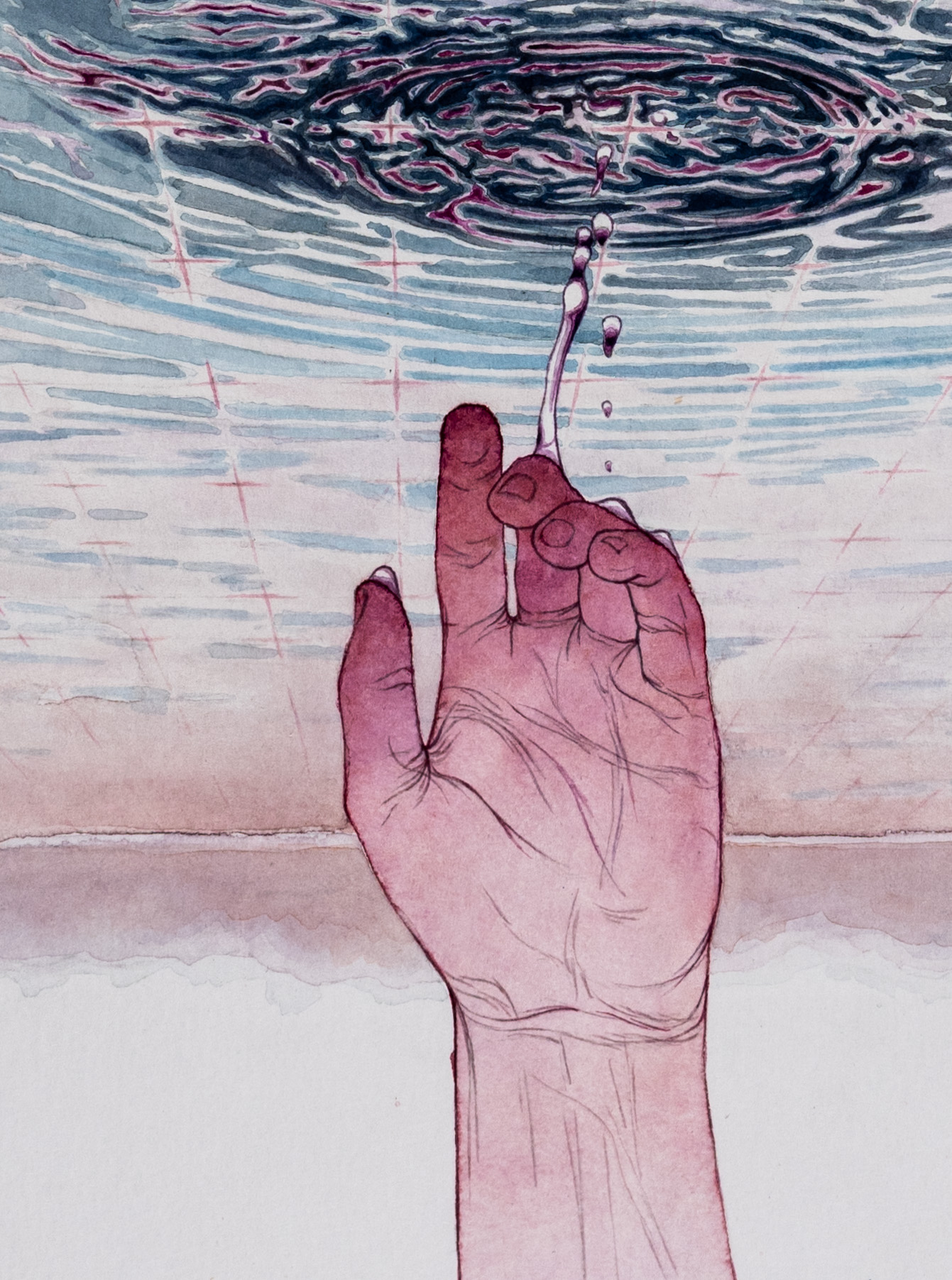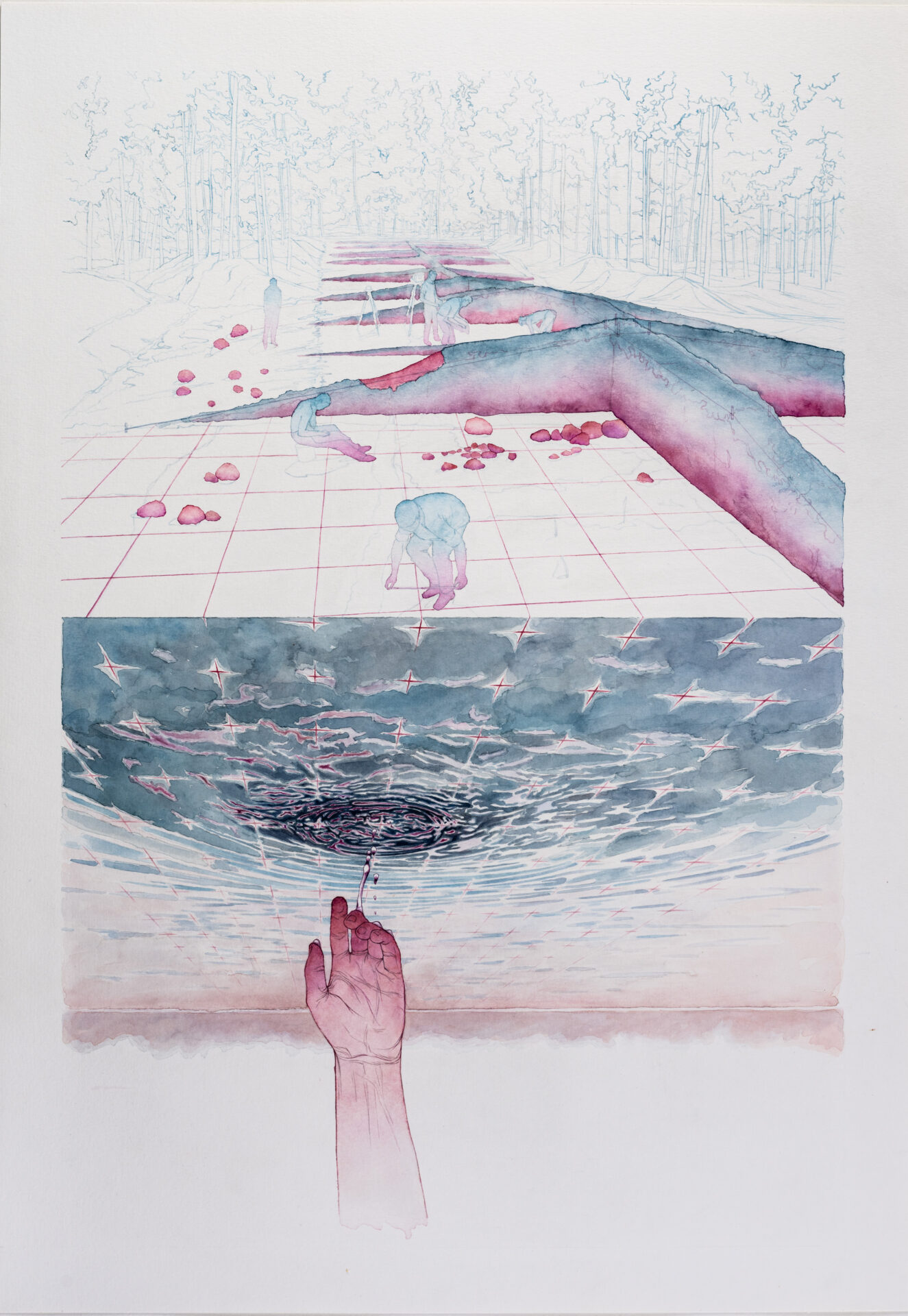A body borrowed from space | Marta Węglińska
Meritorical support: Ewa Mrozikiewicz
Gallery Curators’LAB, 12 Nowowiejskiego Str.
Opening: 26.09.2023, 18:00
26.09 – 15.10.2023
The presented works were created to meet the need for multidimensional contact with the natural environment.
Text: Marta Węglińska and Ewa Mrozikiewicz

You probably consider yourself a sophisticated being – and you certainly are – but know that you are made up of a multitude of elements and compounds that were once waste and then recycled. Don’t worry, this applies to all of us[1].
Marta
The natural environment, the processes taking place in it, constant changes, the wildest places, the least transformed by human activity are the basis for my work. I observe nature from many perspectives – biology, geology, religion, philosophy, culture. At the same time, I combine this knowledge with a quite personal, individual approach, dominated by intuition and a multi-sensory experience of reality.
I spend a lot of time outdoors, traveling alone, on foot or by bike. I listen, I observe, I touch, I breathe, I feel – all my senses become active quite quickly, it’s enough to be alone in the middle of an old forest or somewhere in a dark rocky ravine. I’m not in a hurry, I usually stop for a long time in selected places, I look at everything, from the sky to the ground. Sometimes I sit down and can’t take my eyes off the fern, the water, the wetland, or some rock. Other times I practice qigong, slow body gestures and focusing on breathing during exercises allow me to feel the natural space even more deeply. A rather unusual, multidimensional map is then created, which I give to the memory of my body.
Places that are special to me become inspirations and characters in paintings and films. Working with and on them is like an extension of them, or perhaps more of a curved extension in time. For me, the painting process is a kind of meditation with the place I work with in a given painting. A state of suspension, a different concentration, being in the painting and the landscape at the same time.
Ewa:
In the pictures, painstakingly painted in watercolor, we see natural landscapes with which Marta is emotionally attached, combined with representations of human bodies. The artist creates unpretentious, authentic and aesthetically sublime works. In the works, a person, integrated into the natural environment, is in sensual contact with it. The artist focuses on detail: feet stand on a stone, a hand emerges from the water, human limbs mingle like roots. It also shows erotic intimacy: the body gives way and softens under the pressure of the lover’s hand, the couple unites during the rapture of love.
Closeness to nature and physical closeness between people is clearly emphasized, also by Marta’s attitude towards life and her sincere fascination with the natural environment. I think that, like me, she would fall in love with the theories created by Marija Gimbutas regarding the culture prevailing in Old Europe[2]. In her research, the anthropologist creates visions of a peaceful society that lived not only in harmony with nature, but also created a deep sacredness around it. The Great Mother was worshiped and took care of humanity, ensuring the fertility of the land and abundant harvests. The most important deity was then omnipresent in the surrounding world, sensual and material, not distant, cold and enchanted in the theological mind like the later Christian God the Father. Death involved returning to the goddess’s womb and reconnecting with the universe, so it was not as terrifying as we know it today. Humanity did not wait for salvation and absolution, because man’s presence on earth was already a contact with the most sacred element, and not a punishment for evil progress. Nature was the basis for creating culture and religion, worshiped like today’s churches. Human intimacy was then free from sin, and as sacred and obvious as the sexuality of nature around us.
One of my favorite deities, also worshiped through sexual gestures and rituals, is the Eastern Slavic Mokosz. Her name comes from the native words wet and soak (Proto-Slavic *mokrъ-), she is associated with the cult of moist earth, sometimes called the Damp Lady. Mokosz was identified with fertile, pregnant and yielding land. Therefore, it was customary to whisper one’s sins and dreams to the earth, and the spring earth was treated with respect like a pregnant woman – one did not pull out the grass, did not plow it, could not hit it, drive stakes in it, or even fall to the ground. To ensure fertility and emphasize importance, sacrifices were buried in the ground, women and men exposed their genitals, asking for abundant harvests from the fields, and sexual intercourse was also simulated or performed to ensure prosperity. There was nothing obscene about it, because unity with nature gave these activities a deeper meaning, and their ritual nature ensured a place in the sphere of the sacred. This type of sexual rites related to Serbian culture and tradition is mentioned by Marina Abramović in the video Balkan Erotic Epic from 2005, which, as we can read in the description of the work, is a manifestation of the need for a cultural change of point of view about sex[3]. I have the impression that Marta’s works also call for such a change, equating human bodies with earthly bodies, i.e. the natural environment, emphasizing sexuality as the source of all life in general.
Every second, thousands of unstable carbon isotopes decay in every cell in your body. Some of it came from cosmic radiation, which can turn nitrogen in the atmosphere into carbon-14. Some of it is the result of the breakdown of unstable minerals found in the earth. The rest is the result of thermonuclear explosions during the Cold War[4].
Marta:
The idea of macro and microcosm, assuming the existence of correspondence between the big and small world (the occurrence of analogous laws and principles), is the second thread that appears at the exhibition. Water, air, earth, rocks and vegetation function here in direct connection with the human body. This concept has been present since ancient times and occurs in various cultures, including: Slavic, as well as the more distant one – Javanese, which I had the opportunity to observe while living for a long time in Indonesia, in the city of Yogyakarta. Man’s connection with the cosmos and, more closely, with the natural world functions there in ancient and current beliefs and spiritual practices. In Yogyakarta, cosmology and rituals result from, among others, from its location between powerful elements – the Indian Ocean and the Merapi Volcano. In the film Tendency to Collapse presented at the exhibition, the narrative comes from a traditional story in which Prince Panji and Princess Candrakirana, fleeing from enemies, hide in a tropical forest. Nature gives them shelter, the characters literally blend into the greenery, which is why they cannot recognize themselves.
In my opinion, artistic practice in times of climate crisis should point to the sources of the problem we are currently facing. Without understanding the reasons (separation of man from nature; opposition of culture and nature), it is more difficult to effectively introduce changes in the treatment of the natural environment so that they are clear to society.
The attitude presented at the exhibition refers to the term deep ecology[5], a trend created in the 1970s by the Norwegian professor Arne Naess. This theory combines philosophical aspects with the sphere of feelings, spirituality and everyday activity. It assumes the need to ask questions: about the causes of the climate crisis, how we want to live, and what beliefs we want to follow. At the ideological level, the basis of deep ecology is the belief that man is part of the earth, not an entity separated from it, which is directly referred to in the title of my exhibition.
[1] Curt Stager, You came from garbage, https://przekroj.pl/nauka/ze-szrotu-powstales-curt-stager
Curt Stager – ecologist and climate researcher at Paul Smith’s College, New York State
[2] term refers to Neolithic Europe, and most traces of the culture of Old Europe remain in Malta, Crete and the Balkans
[3] source: https://archive.org/details/Balkan-Erotic-Epic
[4] Curt Stager, works. quote
[5] https://dzikiezycie.pl/archiwum/1997/kwiecien-1997/czym-jest-gleboka-ekologia

- Author: o.petrenko
- Published on: 13.09.2023, 15:57
- Last edit: 13.09.2023, 16:02

